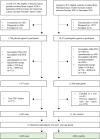Sex-specific associations of empirically derived dietary patterns with colorectal cancer risk in a Korean population: a case‒control study
- PMID: 38509114
- PMCID: PMC10954725
- DOI: 10.1038/s41598-024-55524-5
Sex-specific associations of empirically derived dietary patterns with colorectal cancer risk in a Korean population: a case‒control study
Abstract
Dietary patterns may be a crucial modifiable factor in colorectal cancer (CRC) risk. This study aimed to examine the associations of dietary patterns derived from two methods with CRC risk in Korea. In a study of 1420 CRC patients and 2840 control participants, we obtained dietary patterns by principal component analysis (PCA) and reduced rank regression (RRR) using 33 predefined food groups. The associations between dietary patterns and CRC risk were assessed using unconditional logistic regression models to calculate odds ratios (ORs) and 95% confidence intervals (CIs). We identified two similar dietary patterns, derived from PCA 1 (prudent) and RRR (healthy), characterized by higher consumption of green/yellow vegetables, light-colored vegetables, fruits, eggs, and milk in both men and women. In women, higher prudent and healthy pattern scores were significantly associated with a lower risk of CRC (prudent, ORQ4 vs. Q1 = 0.59, 95% CI 0.40-0.86, P for trend = 0.005; healthy, ORQ4 vs. Q1 = 0.62, 95% CI 0.43-0.89, P for trend = 0.007). In men, a significant inverse association between dietary pattern and risk of rectal cancer was found only for the healthy dietary pattern (ORQ4 vs. Q1 = 0.66, 95% CI 0.45-0.97, P for trend = 0.036). Compared with the dietary pattern derived by PCA, the RRR dietary pattern had a slightly stronger association with a lower risk of distal colon cancer (ORQ4 vs. Q1 = 0.58, 95% CI 0.35-0.97, P for trend = 0.025) and rectal cancer (ORQ4 vs. Q1 = 0.29, 95% CI 0.15-0.57, P for trend < 0.001) in women. Our findings suggest cancer prevention strategies focusing on a diet rich in vegetables, fruits, eggs, and milk. Moreover, the use of both PCA and RRR methods may be advantageous to explore the associations between dietary patterns and risk of CRC.
© 2024. The Author(s).
Conflict of interest statement
The authors declare no competing interests.
Figures
Similar articles
-
Low adherence to the western and high adherence to the mediterranean dietary patterns could prevent colorectal cancer.Eur J Nutr. 2019 Jun;58(4):1495-1505. doi: 10.1007/s00394-018-1674-5. Epub 2018 Mar 26. Eur J Nutr. 2019. PMID: 29582162
-
Dietary patterns and colorectal cancer risk in a Korean population: A case-control study.Medicine (Baltimore). 2016 Jun;95(25):e3759. doi: 10.1097/MD.0000000000003759. Medicine (Baltimore). 2016. PMID: 27336862 Free PMC article.
-
Association of preserved vegetable consumption and prevalence of colorectal polyps: results from the Lanxi Pre-colorectal Cancer Cohort (LP3C).Eur J Nutr. 2022 Apr;61(3):1273-1284. doi: 10.1007/s00394-021-02719-5. Epub 2021 Nov 8. Eur J Nutr. 2022. PMID: 34750639
-
Difference in Gastrointestinal Cancer Risk and Mortality by Dietary Pattern Analysis: A Systematic Review and Meta-Analysis.Nutr Rev. 2025 Mar 1;83(3):e991-e1013. doi: 10.1093/nutrit/nuae090. Nutr Rev. 2025. PMID: 39018497 Free PMC article.
-
Dietary patterns derived from principal component analysis (PCA) and risk of colorectal cancer: a systematic review and meta-analysis.Eur J Clin Nutr. 2019 Mar;73(3):366-386. doi: 10.1038/s41430-018-0234-7. Epub 2018 Jul 26. Eur J Clin Nutr. 2019. PMID: 30050075
Cited by
-
Dietary choline intake and colorectal cancer: a cross-sectional study of 2005-2018 NHANES cycles.Front Nutr. 2024 Jun 3;11:1352535. doi: 10.3389/fnut.2024.1352535. eCollection 2024. Front Nutr. 2024. PMID: 38887505 Free PMC article.
References
MeSH terms
Grants and funding
LinkOut - more resources
Full Text Sources
Medical


